Looking at the current projector, the working principle of the chip is nothing more than CRT, LCD, DLP, LCOS. As the most mature technology, CRT has a wide color gamut that is not comparable to other projectors! However, its inability to carry out industrial production has resulted in its expensive, bulky volume and cumbersome adjustments that will make it impossible to get rid of the "Lian Pang Lao" ending. However, the excellent display performance makes it still used in high-end applications. This kind of projector is represented by SONY G90, which makes it appear in the simulators of aviation and navigation. Currently in the commercial and home market, it is basically divided by two projectors, LCD and DLP projectors. But the LCOS projector is also showing great vitality.
Principles, features and technical development of CRT, LCD, DLP and LCOS:
1. Principles, features and technical development of CRT projectors:
The CRT projector, also known as the three-gun projector, is mainly composed of three CRT tubes. CRT (Cathode Ray Tube) is a cathode ray tube, which is mainly composed of an electron gun, a deflection yoke and a tube screen. In order to make the CRT tube display image information on the screen, the CRT projector decomposes the input signal source into the phosphor screens of three CRT tubes of R (red), G (green), and B (blue), and the phosphor emits light under the action of high pressure. , through the optical system to zoom in and converge, display a color image on the large screen.
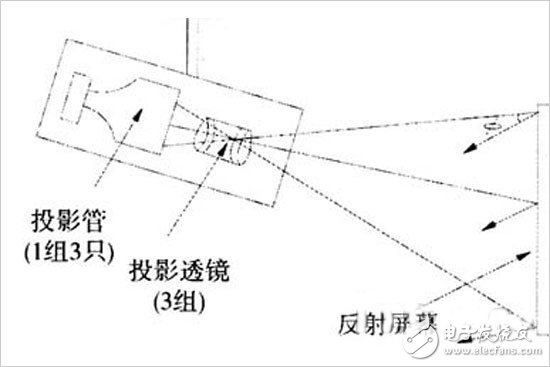
(The picture shows the three-gun CRT display schematic)
2. Principles, features and technical development of LCD projectors:
Liquid crystal display technology utilizes the photoelectric effect of liquid crystals. The photoelectric effect of the liquid crystal means that a certain arrangement state of the liquid crystal molecules changes the light transmittance or reflectance of the liquid crystal cell due to an applied electric field. The LCD projector uses a metal halide lamp or a UHP (cold light source) to provide an external light source, and the liquid crystal panel serves as a light control layer. The electrical signal generated by the control system controls the liquid crystal of the corresponding pixel, and the change in the transparency of the liquid crystal controls the light passing through the liquid crystal. Intensity, produces signals with different gray levels and colors, displays output images, and belongs to passive projection.

(The picture is a three-chip LCD display schematic)
At present, the most common LCD projectors on the market have three-chip and single-chip microcomputers. Usually, the three-chip machine uses three red, green and blue liquid crystal panels as the control layer for red, green and blue light. The white light emitted by the light source is concentrated by the lens group and reaches the dichroic mirror group. The red light is first separated and projected onto the red liquid crystal panel. The corresponding pixels on the liquid crystal panel receive the electronic signal from the signal source, showing different transparency. The image information represented by the transparency is projected, and red light information in the image is generated. The green light is projected onto the green liquid crystal panel to form green light information in the image, and the blue light is also generated by the blue liquid crystal panel to generate blue light information in the image. Light of three separate colors converges in the prism and is projected onto the projection screen by the projection lens to form a full-color image. In addition to the three-chip LCD projector, there is a single-chip microcomputer. It integrates red, green and blue three primary colors in a liquid crystal panel, and then performs spatial color mixing on the screen. This kind of single-chip microcomputer has the advantages of small size, light weight, extremely convenient operation and carrying, low price, etc., but because of its liquid crystal monochrome The opening ratio is low, the principle of color mixing is spatial color mixing, and the graininess is obvious. It has been basically eliminated, and is currently only used in low-end projectors.
In recent years, LCD panel technology has also made great progress, mainly in the following aspects: 1. The use of microlens technology: one microlens is designed at each pixel of the liquid crystal panel, and its advantage is to improve The aperture ratio of the liquid crystal improves the brightness of the LCD projector and also reduces the graininess of the projected image. 2. With the introduction of the 0.5-inch LCD panel, LCD projectors have greatly improved the miniaturization of DLP projectors. The introduction of small-size LCD panels has also led to a large number of industrial production of LCD projectors. Lowering prices paves the way.
3, DLP projector principle, characteristics and technical development:
The DLP technology patent is owned by Texas Instruments (TI), and the core components such as DMD chips and DMD controllers are still exclusively provided by TI. After several years of development, the application field of DLP technology is gradually expanding. Its application fields include digital cinema, large-screen splicing display, front-projection projectors, and all aspects of large-screen display such as rear projection TV. The advantages of DLP technology are: DLP technology is based on reflective DMD, is a pure digital display mode, each pixel in the image is generated by digitally controlled 3 primary colors, each color has 8 to 10 The gray level of the bit, this digital characteristic of DLP technology, allows for accurate digital gray levels as well as color reproduction. Compared with the transmissive liquid crystal display LCD technology, the projected image is more delicate; no polarized light is required, and the application of the light efficiency is high; in addition, the pixel pitch of the projected image of the DLP technology projection product is small, and the formation is almost seamless. Picture of the picture. It is based on the above reasons that DLP projector products generally have high contrast, black and white images are clear and sharp, rich in dark parts and rich in detail; in the display of computer signal black and white text, the picture is accurate, the color is pure, and the edge contour is clear.
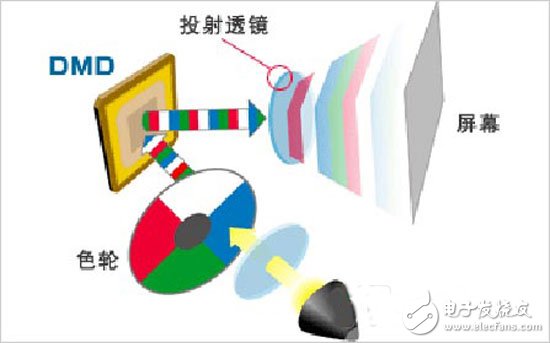
(The picture is a single-chip DLP display schematic)
According to the number of DMD digital micromirrors included in the DLP projector, the projector is divided into a single-chip DLP projector, two DLP projectors and three DLP projectors.
Many DLP projectors currently on the market belong to single-chip microcomputers. This single-chip DLP projector is mainly used in various portable projection products. The whole body of this projector is generally smaller than the area of ​​A4 paper. Designed by the executives, the outer casing is generally elegant and beautiful magnesium alloy casing. Don't look at the small size of this single-chip DLP projector, but its function is powerful, high definition, uniform image and sharp color. This kind of projector, when you want to work, you can put it into the briefcase at any time, set off immediately, and directly show the customer the effect of beautiful color and clear picture.
Compared with the single-chip DLP projector, the two DLP projectors use one DMD chip, one of which controls the red light separately, and the other controls the reflection of the blue and green light. The same as the single-chip DLP projector, the high speed is used. The rotating color wheel produces a full-color projection image that is primarily used in large display walls for large entertainment venues and for users who require large-area display screens.
Three DLP projectors, three DMD chips reflect one of the three primary colors, no longer need to use the color wheel to filter; the projector made with three DMD chips can reach 12000 ANSI lumens, which is abandoned. Convergence in the traditional sense, can be zoomed at will, the adjustment is very convenient; only the resolution is not high, the compression resolution can only reach 1280&TImes; 1024 such standard, it is often used in special occasions with very high brightness requirements.
At present, DLP technology is developing in the direction of low cost and high image quality. On the one hand, TI has improved its own production and processing technology, improved the yield of DMD, and improved the DMD product series on the other hand, thus adapting to different levels. Product application requirements. In the technical implementation of improving the picture quality of DLP projectors, TI released SCR (Sequential Color Recapture) technology to enhance the brightness and color performance of projectors; in the second half of 2002, DLP projectors were used on the optical path. The six-segment color wheel further enhances color and brightness.
4. Principles, features and technical development of LCOS projectors:
The basic principle of LCOS (Liquid Crystal On Silicon) projector is similar to that of LCD projector, except that LCOS projector uses LCOS panel to modulate the light signal emitted by the light source to be projected onto the screen. The LCOS panel uses a CMOS chip as a circuit substrate and a reflective layer. The liquid crystal is injected between the CMOS integrated circuit chip and the transparent glass substrate. The CMOS chip is polished and polished as a mirror, and the light is transmitted through the glass substrate and the liquid crystal material. After dimming, it is reflected from the surface of the chip.
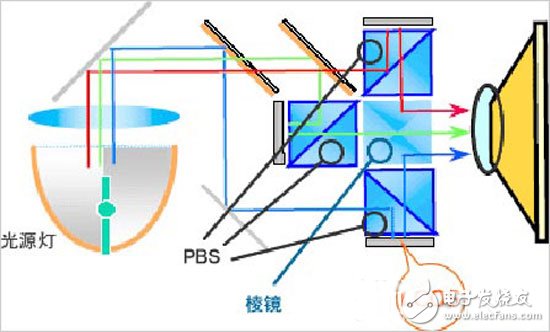
(The picture shows three LCOS display schematics)
The biggest difference from LCD projectors is that LCD projectors use light sources to pass through the LCD for modulation. They are transmissive, while LCOS projectors use a reflective structure, so the light emitted by the light source does not penetrate the LCOS panel. , is a reflection type.
Projectors using LCOS technology typically use three LCOS panels. The LCOS panel uses a CMOS chip as the circuit substrate and cannot pass light directly. Therefore, in the LCOS projector system, a PBS (Polarization Beam Splitter) is added in front of the LCOS panel to beam the incident LCOS panel. Separated from the reflected beam. In addition to PBS, the main structure of the LCOS projector is similar to the LCD projector in the design of the light guiding and splitting sections.
LCOS projection technology is the latest projection technology developed after 2000. LCOS projectors have great potential for high-resolution projection. LCOS projectors currently on the market are usually SXGA (1365×1024) or higher. Since the transistor and the driving circuit of the LCOS are fabricated in the silicon substrate and are located below the reflecting surface, which does not occupy the surface area, only the pixel gap occupies the opening area. In a transmissive LCD projector, a transistor controlled as a pixel point switch is placed at a corresponding position on the liquid crystal panel. During the transmission of the light source, the transistor itself blocks part of the light, and thus the projector using the transmissive liquid crystal technology The light source utilization efficiency is not high, only 3 to 10%. Therefore, in theory, LCOS will have higher resolution or aperture ratio than penetrating LCD. The pixel grid structure on the screen is almost invisible, and the light utilization efficiency can reach 40% or more, thus achieving greater light output and more complete color. . Compared with the sharp digital image brought by DLP micro-mirror, the pixel edge of LCOS projector is smoother, which effectively eliminates the jagged phenomenon of the image and is suitable for users who like natural and soft images.
The manufacturing technology of LCOS projectors is divided into the front-end semiconductor CMOS manufacturing and the subsequent liquid crystal panel bonding package manufacturing. The former semiconductor CMOS manufacturing has mature design, simulation, production and testing technology, so the current yield rate has reached more than 90%, and the cost is extremely low. The rear LCD panel is packaged and manufactured, and the current yield is low, which is said to be only about 30%. At present, LCOS projectors are affected by their prices, sales are far less than LCD and DLP projectors, but LCOS is the lowest cost technology projection technology. The maturity of LCD panel manufacturing provides room for improvement in LCOS yield. The manufacturing cost of the product is expected to be further reduced.
LCOS projectors currently face the following problems in product technology. First, the contrast of LCOS projectors is usually between 500:1 and 800:1, which is not as good as DLP projectors. The weight of the LCOS projector is also incomparable with portable LCD and DLP projectors. The lightest LCOS projector currently weighs about 5.5kg. Compared to LCD and DLP, LCOS is more suitable for use in fixed conference rooms or home theaters.
LCOS is a universal projection technology, including different types, and is now undergoing polarization development: one is for large-size rear projection TVs, which is currently the mainstream application of LCOS, and the other is for high resolution of small size. The rate is portable, and the D-ILA technology from JVC is relatively mature. After mass production and cost issues are resolved, such products will have the opportunity to be used in a wider range of applications in the front projection market.
Comparison of parameters of CRT, LCD, DLP and LCOS projection chips:
CRT, LCD, DLP and LCOS projection chips each have their own technical characteristics. The color gamut of CRT projection is the standard. It can be clearly seen from the following figure that the color gamut of LCD and its derived LCOS projection chip is very wide. Its color gamut range is much larger than that of CRT and DLP chips.
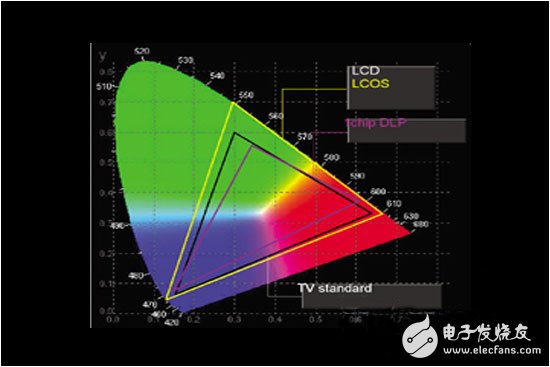
(Three mainstream projector chip gamut diagrams: Black triangle is CRT TV standard; magenta is DLP; yellow is LCD and LCOS.)
As an application area sensitive to color gamut, three-chip LCD and LCOS projection chips are the first choice in these fields. However, due to the large number of TFTs (ThinFilmTransistor thin film transistors) integrated on the chip, it is inevitable that there will be damaged or failed TFTs in the production process, which is always in the on or off state, which inevitably causes bright spots in the image or Dark spots, and, such damaged TFTs continue to increase with the use of time. This is the soft underbelly of LCD and LCOS chips. DLP is characterized by high contrast and high reliability.
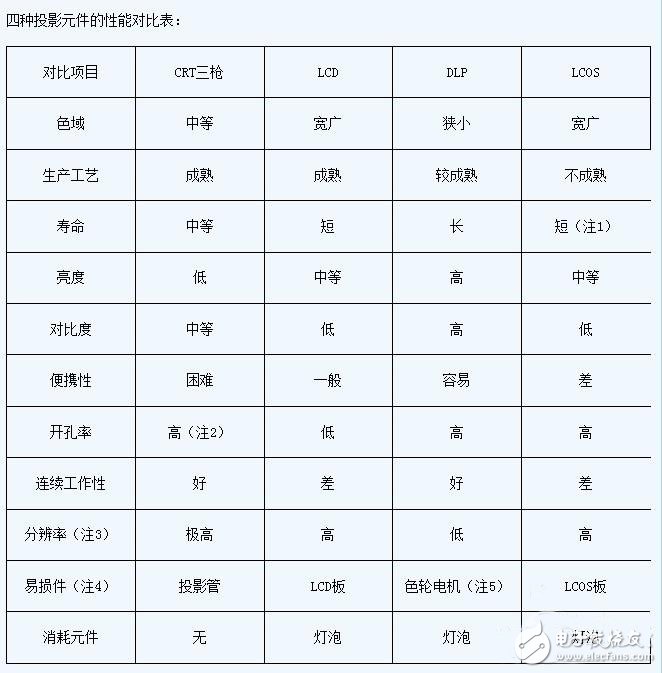
Note 1: This parameter is analogous to the parameters of the LCD because there is no relevant information.
Note 2: The CRT has no opening ratio. This parameter is the analogy parameter of the latter three.
Note 3: The resolution parameter is a product under the same technical conditions and mature production process.
Note 4: The enumeration of the parameters of the consumables is listed for the probability of failure of different chips relative to other components. It is not that the component is particularly vulnerable to damage (or the component must be damaged before the end of the service life of the device). of!)
Note 5: The color wheel motor exists only in single-chip and two-chip DLP machines, and there is no such component in three-chip DLP projectors.
CRT, LCD, DLP and LCOS projection market share and development:
The projector products on the market today are mainly LCD projectors and DLP projectors. Since the introduction of the first DLP projector in 1996, the share of DLP projectors in the Chinese projector market has increased from 15.4% in 2000 to 26.4% in 2002. According to information from Pacific Media Associates, DLP products have achieved remarkable growth in the global market share of monitors before 2004. As of 2004, the global market share of DLP front projection products reached 47. %, compared with the third quarter of the same year, the growth rate reached an unprecedented high of 8%, while increasing by nearly 14 percentage points from the fourth quarter of 2003. According to data from the Pacific Media Association, DLP technology has reached 77% market share in the high-end home theater market ($10,000 plus market price), which has extremely high visual requirements.
It is the unique advantages of DLP technology - superb picture clarity, no burn-in, no fading, rich and colorful color performance, and the industry's amazing contrast, etc. - attract more and more users. Select this product.
However, due to the narrow color gamut of single-chip DLP products and the cost of multi-chip DLP products, it also affects the purchasing factors of most people in DLP. The advantages of LCD (liquid crystal) projectors are high resolution (up to XGA standard) and low price. High brightness and uniform image. UHP cold light source is usually used. The image is rich in color and the picture is good. The disadvantage is that it requires good heat dissipation conditions. It can be widely used in teaching, large-scale conference demonstration, business office, multimedia theater and mobile office. field. At present, the market share of LCD is still much higher than DLP. It can be seen that some people choose the projector for the color gamut, flexible resolution and price.
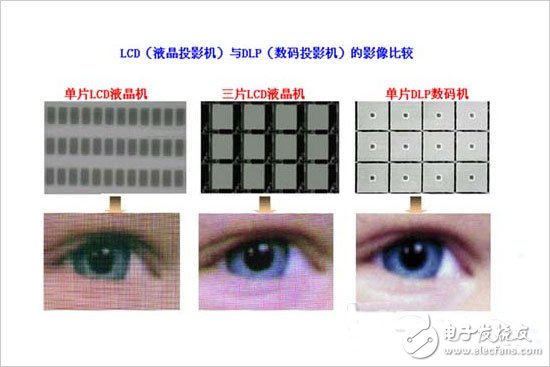
(Single-chip LCD, three-chip LCD and single-chip DLP effect comparison chart)
The advantage of CRT projector is that the displayed image is rich in color, good in reductibility, and has rich geometric distortion adjustment capability. The disadvantage is that image resolution and brightness are mutually restricted. CRT projectors are generally large in size, and many CRT projectors are at 50Kg. the above.
The currently recognized mainstream projection technologies are LCD and DLP, and the two have almost formed a pattern of equal division. In the underlying technology field, LCD technology and DLP technology still dominate the projector market. The high-profile LCOS technology is still not well solved due to its inherent technical defects, and it stays in the engineering prototype stage for a short time. It is difficult to make a difference in the field of projectors. However, once the LCOS technology solves the limitations of the manufacturing process, the product structure is simple, and the low-cost advantage will surely grab a share of the market share of LCD and DLP, forming a three-point world of LCOS, LCD and DLP.
Extrusion Neon LED Strip the hottest product in the world. It is extruded and has good waterproof performance.
The milky white cover makes the led strips soft and even, single color and RGB ,colorful and other colors are optional
and the external controller can achieve the effect. IP68 waterproof can be used for outdoor decoration,
often used for building decoration, Christmas decoration and other places. The installation is simple and convenient,
the repair is simple, and the scope of application is wide.
Extrusion Neon Led Strip
LED Neon Lights,Neon LED Strip Lights,Extrusion LED Neon Flex Strip,Extrusion Neon LED Strip
SHEN ZHEN SEL LIGHTING CO.,LTD , https://www.sel-lighting.com